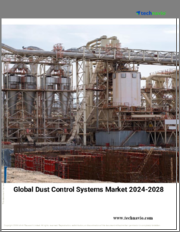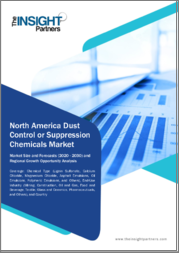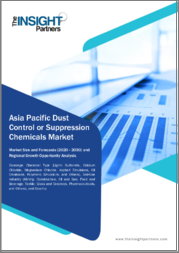
|
시장보고서
상품코드
1722472
먼지 제어 시스템 및 먼지 억제 화학제품 시장 보고서 : 화학제품 유형, 시스템 유형, 최종사용자, 지역별(2025-2033년)Dust Control Systems and Suppression Chemicals Market Report by Chemical Type, System Type, End User, and Region 2025-2033 |
||||||
세계 먼지 제어 시스템 및 먼지 억제 화학제품 시장 규모는 2024년 149억 달러에 달했습니다. 향후 IMARC Group은 이 시장이 2033년까지 204억 달러에 달하고, 2025-2033년 3.55%의 연평균 성장률(CAGR)을 보일 것으로 예측하고 있습니다.
먼지 제어 시스템 및 먼지 억제 화학제품은 대기 중의 배기가스와 먼지를 제거하여 공기 질을 개선하기 위해 상업 분야에서 널리 사용되는 일련의 솔루션입니다. 또한, 비포장 도로 표면의 처리에도 활용되고 있습니다. 가장 일반적인 먼지 억제제에는 폴리머 유제, 염화마그네슘(MgCI2), 염화나트륨(NaCl), 염화칼슘(CaCI2)과 같은 염류 용액이 있습니다. 한편, 먼지 제어는 관성 분리기, 습식 세정기, 습식 스크러버, 유닛 컬렉터, 백필터, 전기 집진기 등 다양한 유형이 시판되고 있습니다.
먼지 제어 시스템 및 먼지 억제 화학제품 시장 동향 :
산업 부문의 급속한 성장과 석유 및 광산에서 작업자의 안전을 보장하기 위한 먼지 제어 시스템 및 먼지 억제 화학제품에 대한 수요 증가가 시장 성장의 주요 요인으로 작용하고 있습니다. 또한, 용도의 단순화, 긴 수명 보호 및 신뢰성으로 인해 기존 방식보다 고급 먼지 억제 솔루션에 대한 사용자들의 선호도가 높아지면서 시장을 주도하고 있습니다. 이에 따라 건설 현장, 도로, 하드스탠드 지역, 타막, 발수성 포장과 관련된 다양한 문제를 해결하기 위해 최첨단 먼지 억제 솔루션 및 억제 화학제품의 사용이 증가하고 있으며, 이는 시장 성장에 기여하고 있습니다. 이와 더불어, 기술적으로 진보된 먼지 제어 시스템의 도입이 시장 성장을 가속하고 있습니다. 예를 들어, 2019년 12월 미국의 BossTek은 공기 흐름 조절 기능으로 구성된 가변 주파수 구동(VFD) 시스템을 출시하여 포트폴리오를 확장했습니다. 또한, 근로자에게 위생적이고 안전한 작업 환경을 제공하여 근로자의 안전 기준을 충족시키기 위해 여러 국가의 정부가 시행하고 있는 수많은 이니셔티브는 전 세계 시장 성장을 적극적으로 촉진하고 있습니다.
본 보고서에서 다룬 주요 질문
- 먼지 제어 시스템 및 먼지 억제 화학제품 시장 규모는?
- 2025-2033년 먼지 제어 시스템 및 먼지 억제 화학제품 세계 시장 성장률 전망은?
- 먼지 제어 시스템 및 먼지 억제 화학제품 세계 시장을 이끄는 주요 요인은?
- 코로나19가 먼지 제어 시스템 및 먼지 억제 화학제품 세계 시장에 미치는 영향은?
- 먼지 제어 시스템 및 먼지 억제 화학제품 세계 시장에서의 화학 유형별 분류는?
- 먼지 제어 시스템 및 먼지 억제 화학제품 세계 시장에서의 시스템 유형별 분류는?
- 먼지 제어 시스템 및 먼지 억제 화학제품 세계 시장 최종 사용자별 분류는?
- 먼지 제어 시스템 및 먼지 억제 화학제품 세계 시장에서 주요 지역은?
- 먼지 제어 시스템 및 먼지 억제 화학제품 세계 시장에서 주요 기업은?
목차
제1장 서문
제2장 조사 범위와 조사 방법
- 조사 목적
- 이해관계자
- 데이터 소스
- 1차 정보
- 2차 정보
- 시장 추정
- 보텀업 접근
- 톱다운 접근
- 조사 방법
제3장 주요 요약
제4장 서론
- 개요
- 주요 업계 동향
제5장 세계의 먼지 제어 시스템 및 먼지 억제 화학제품 시장
- 시장 개요
- 시장 실적
- COVID-19의 영향
- 시장 예측
제6장 시장 분석 : 화학제품 유형별
- 염화칼슘
- 리그닌 술폰산염
- 염화마그네슘
- 아스팔트 에멀전
- 오일 에멀전
- 폴리머 에멀전
- 기타
제7장 시장 분석 : 시스템 유형별
- Dry Collection
- Wet Suppression
제8장 시장 분석 : 최종사용자별
- 건축 및 건설
- 광업
- 식품 및 음료
- 석유 및 가스, 석유화학
- 의약품
- 기타
제9장 시장 분석 : 지역별
- 북미
- 미국
- 캐나다
- 아시아태평양
- 중국
- 일본
- 인도
- 한국
- 호주
- 인도네시아
- 기타
- 유럽
- 독일
- 프랑스
- 영국
- 이탈리아
- 스페인
- 러시아
- 기타
- 라틴아메리카
- 브라질
- 멕시코
- 기타
- 중동 및 아프리카
- 시장 내역 : 국가별
제10장 SWOT 분석
- 개요
- 강점
- 약점
- 기회
- 위협
제11장 밸류체인 분석
제12장 Porter의 Five Forces 분석
- 개요
- 바이어의 교섭력
- 공급 기업의 교섭력
- 경쟁 정도
- 신규 진출업체의 위협
- 대체품의 위협
제13장 가격 분석
제14장 경쟁 구도
- 시장 구조
- 주요 기업
- 주요 기업 개요
- Applied Conveyor Technology Inc.
- Benetech Inc.
- Borregaard AS
- Cargill Incorporated
- Donaldson Company Inc.
- Ecolab Inc.
- Hexion Inc.
- Nederman Holding AB
- Quaker Chemical Corporation
- Savic Group
- SUEZ
The global dust control systems and suppression chemicals market size reached USD 14.9 Billion in 2024. Looking forward, IMARC Group expects the market to reach USD 20.4 Billion by 2033, exhibiting a growth rate (CAGR) of 3.55% during 2025-2033.
Dust control systems and suppression chemicals are a set of solutions, which are extensively deployed in the commercial sector for enhancing air quality by removing emissions and dust particles from the air. They are further utilized for treating unpaved surfaces. Some of the most common dust suppression chemicals include polymer emulsion, magnesium chloride (MgCI2), sodium chloride (NaCl) and calcium chloride (CaCI2) and other saline solutions. On the other hand, dust controls are commercially available in varying types like inertial separators, wet scrubbers, unit collectors, fabric filters and electrostatic precipitators.
Dust Control Systems and Suppression Chemicals Market Trends:
The rapid growth in the industrial sector, along with the increasing demand for dust control systems and suppression chemicals for ensuring the safety of toilers while extracting oil and mining, represents key factors primarily driving the market toward growth. The market is further being driven by the growing inclination of users toward advanced dust suppression solutions over conventional methods due to simplified application, long-life protection, and reliability. In line with this, the escalating utilization of state-of-the-art dust control solutions and suppression chemicals for dealing with the various problems associated with construction sites, roads, hardstand areas, tarmacs and repellent pavement is contributing to the market growth. Besides this, the introduction of technologically advanced dust controlling systems is propelling the market growth. For instance, In December 2019, BossTek, a United States-based firm, expanded its portfolio by launching a variable frequency drive (VFD) system consisting of an airflow adjustment feature. Additionally, the numerous initiatives undertaken by the governments of various nations for meeting workers safety standards by providing them a hygienic and safe work environment are positively stimulating market growth across the globe.
Key Market Segmentation:
Breakup by Chemical Type:
- Calcium Chloride
- Lignin Sulfonate
- Magnesium Chloride
- Asphalt Emulsions
- Oil Emulsions
- Polymeric Emulsions
- Others
Breakup by System Type:
- Dry Collection
- Wet Suppression
Breakup by End User:
- Building and Construction
- Mining
- Food and Beverage
- Oil & Gas and Petrochemical
- Pharmaceutical
- Others
Breakup by Region:
- North America
- United States
- Canada
- Asia-Pacific
- China
- Japan
- India
- South Korea
- Australia
- Indonesia
- Others
- Europe
- Germany
- France
- United Kingdom
- Italy
- Spain
- Russia
- Others
- Latin America
- Brazil
- Mexico
- Others
- Middle East and Africa
Competitive Landscape:
The competitive landscape of the industry has also been examined along with the profiles of the key players being Applied Conveyor Technology Inc., Benetech Inc., Borregaard AS, Cargill Incorporated, Donaldson Company Inc., Ecolab Inc., Hexion Inc., Nederman Holding AB, Quaker Chemical Corporation, Savic Group and SUEZ.
Key Questions Answered in This Report
- 1.How big is the dust control systems and suppression chemicals market?
- 2.What is the expected growth rate of the global dust control systems and suppression chemicals market during 2025-2033?
- 3.What are the key factors driving the global dust control systems and suppression chemicals market?
- 4.What has been the impact of COVID-19 on the global dust control systems and suppression chemicals market?
- 5.What is the breakup of the global dust control systems and suppression chemicals market based on the chemical type?
- 6.What is the breakup of the global dust control systems and suppression chemicals market based on the system type?
- 7.What is the breakup of the global dust control systems and suppression chemicals market based on end user?
- 8.What are the key regions in the global dust control systems and suppression chemicals market?
- 9.Who are the key players/companies in the global dust control systems and suppression chemicals market?
Table of Contents
1 Preface
2 Scope and Methodology
- 2.1 Objectives of the Study
- 2.2 Stakeholders
- 2.3 Data Sources
- 2.3.1 Primary Sources
- 2.3.2 Secondary Sources
- 2.4 Market Estimation
- 2.4.1 Bottom-Up Approach
- 2.4.2 Top-Down Approach
- 2.5 Forecasting Methodology
3 Executive Summary
4 Introduction
- 4.1 Overview
- 4.2 Key Industry Trends
5 Global Dust Control Systems and Suppression Chemicals Market
- 5.1 Market Overview
- 5.2 Market Performance
- 5.3 Impact of COVID-19
- 5.4 Market Forecast
6 Market Breakup by Chemical Type
- 6.1 Calcium Chloride
- 6.1.1 Market Trends
- 6.1.2 Market Forecast
- 6.2 Lignin Sulfonate
- 6.2.1 Market Trends
- 6.2.2 Market Forecast
- 6.3 Magnesium Chloride
- 6.3.1 Market Trends
- 6.3.2 Market Forecast
- 6.4 Asphalt Emulsions
- 6.4.1 Market Trends
- 6.4.2 Market Forecast
- 6.5 Oil Emulsions
- 6.5.1 Market Trends
- 6.5.2 Market Forecast
- 6.6 Polymeric Emulsions
- 6.6.1 Market Trends
- 6.6.2 Market Forecast
- 6.7 Others
- 6.7.1 Market Trends
- 6.7.2 Market Forecast
7 Market Breakup by System Type
- 7.1 Dry Collection
- 7.1.1 Market Trends
- 7.1.2 Market Forecast
- 7.2 Wet Suppression
- 7.2.1 Market Trends
- 7.2.2 Market Forecast
8 Market Breakup by End User
- 8.1 Building and Construction
- 8.1.1 Market Trends
- 8.1.2 Market Forecast
- 8.2 Mining
- 8.2.1 Market Trends
- 8.2.2 Market Forecast
- 8.3 Food and Beverage
- 8.3.1 Market Trends
- 8.3.2 Market Forecast
- 8.4 Oil & Gas and Petrochemical
- 8.4.1 Market Trends
- 8.4.2 Market Forecast
- 8.5 Pharmaceutical
- 8.5.1 Market Trends
- 8.5.2 Market Forecast
- 8.6 Others
- 8.6.1 Market Trends
- 8.6.2 Market Forecast
9 Market Breakup by Region
- 9.1 North America
- 9.1.1 United States
- 9.1.1.1 Market Trends
- 9.1.1.2 Market Forecast
- 9.1.2 Canada
- 9.1.2.1 Market Trends
- 9.1.2.2 Market Forecast
- 9.1.1 United States
- 9.2 Asia-Pacific
- 9.2.1 China
- 9.2.1.1 Market Trends
- 9.2.1.2 Market Forecast
- 9.2.2 Japan
- 9.2.2.1 Market Trends
- 9.2.2.2 Market Forecast
- 9.2.3 India
- 9.2.3.1 Market Trends
- 9.2.3.2 Market Forecast
- 9.2.4 South Korea
- 9.2.4.1 Market Trends
- 9.2.4.2 Market Forecast
- 9.2.5 Australia
- 9.2.5.1 Market Trends
- 9.2.5.2 Market Forecast
- 9.2.6 Indonesia
- 9.2.6.1 Market Trends
- 9.2.6.2 Market Forecast
- 9.2.7 Others
- 9.2.7.1 Market Trends
- 9.2.7.2 Market Forecast
- 9.2.1 China
- 9.3 Europe
- 9.3.1 Germany
- 9.3.1.1 Market Trends
- 9.3.1.2 Market Forecast
- 9.3.2 France
- 9.3.2.1 Market Trends
- 9.3.2.2 Market Forecast
- 9.3.3 United Kingdom
- 9.3.3.1 Market Trends
- 9.3.3.2 Market Forecast
- 9.3.4 Italy
- 9.3.4.1 Market Trends
- 9.3.4.2 Market Forecast
- 9.3.5 Spain
- 9.3.5.1 Market Trends
- 9.3.5.2 Market Forecast
- 9.3.6 Russia
- 9.3.6.1 Market Trends
- 9.3.6.2 Market Forecast
- 9.3.7 Others
- 9.3.7.1 Market Trends
- 9.3.7.2 Market Forecast
- 9.3.1 Germany
- 9.4 Latin America
- 9.4.1 Brazil
- 9.4.1.1 Market Trends
- 9.4.1.2 Market Forecast
- 9.4.2 Mexico
- 9.4.2.1 Market Trends
- 9.4.2.2 Market Forecast
- 9.4.3 Others
- 9.4.3.1 Market Trends
- 9.4.3.2 Market Forecast
- 9.4.1 Brazil
- 9.5 Middle East and Africa
- 9.5.1 Market Trends
- 9.5.2 Market Breakup by Country
- 9.5.3 Market Forecast
10 SWOT Analysis
- 10.1 Overview
- 10.2 Strengths
- 10.3 Weaknesses
- 10.4 Opportunities
- 10.5 Threats
11 Value Chain Analysis
12 Porters Five Forces Analysis
- 12.1 Overview
- 12.2 Bargaining Power of Buyers
- 12.3 Bargaining Power of Suppliers
- 12.4 Degree of Competition
- 12.5 Threat of New Entrants
- 12.6 Threat of Substitutes
13 Price Analysis
14 Competitive Landscape
- 14.1 Market Structure
- 14.2 Key Players
- 14.3 Profiles of Key Players
- 14.3.1 Applied Conveyor Technology Inc.
- 14.3.1.1 Company Overview
- 14.3.1.2 Product Portfolio
- 14.3.2 Benetech Inc.
- 14.3.2.1 Company Overview
- 14.3.2.2 Product Portfolio
- 14.3.3 Borregaard AS
- 14.3.3.1 Company Overview
- 14.3.3.2 Product Portfolio
- 14.3.3.3 Financials
- 14.3.4 Cargill Incorporated
- 14.3.4.1 Company Overview
- 14.3.4.2 Product Portfolio
- 14.3.4.3 SWOT Analysis
- 14.3.5 Donaldson Company Inc.
- 14.3.5.1 Company Overview
- 14.3.5.2 Product Portfolio
- 14.3.5.3 Financials
- 14.3.5.4 SWOT Analysis
- 14.3.6 Ecolab Inc.
- 14.3.6.1 Company Overview
- 14.3.6.2 Product Portfolio
- 14.3.6.3 Financials
- 14.3.6.4 SWOT Analysis
- 14.3.7 Hexion Inc.
- 14.3.7.1 Company Overview
- 14.3.7.2 Product Portfolio
- 14.3.8 Nederman Holding AB
- 14.3.8.1 Company Overview
- 14.3.8.2 Product Portfolio
- 14.3.8.3 Financials
- 14.3.9 Quaker Chemical Corporation
- 14.3.9.1 Company Overview
- 14.3.9.2 Product Portfolio
- 14.3.9.3 Financials
- 14.3.9.4 SWOT Analysis
- 14.3.10 Savic Group
- 14.3.10.1 Company Overview
- 14.3.10.2 Product Portfolio
- 14.3.11 SUEZ
- 14.3.11.1 Company Overview
- 14.3.11.2 Product Portfolio
- 14.3.11.3 Financials
- 14.3.1 Applied Conveyor Technology Inc.



















